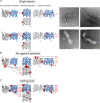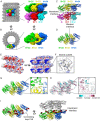Full-length three-dimensional structure of the influenza A virus M1 protein and its organization into a matrix layer
- PMID: 32997652
- PMCID: PMC7549809
- DOI: 10.1371/journal.pbio.3000827
Full-length three-dimensional structure of the influenza A virus M1 protein and its organization into a matrix layer
Abstract
Matrix proteins are encoded by many enveloped viruses, including influenza viruses, herpes viruses, and coronaviruses. Underneath the viral envelope of influenza virus, matrix protein 1 (M1) forms an oligomeric layer critical for particle stability and pH-dependent RNA genome release. However, high-resolution structures of full-length monomeric M1 and the matrix layer have not been available, impeding antiviral targeting and understanding of the pH-dependent transitions involved in cell entry. Here, purification and extensive mutagenesis revealed protein-protein interfaces required for the formation of multilayered helical M1 oligomers similar to those observed in virions exposed to the low pH of cell entry. However, single-layered helical oligomers with biochemical and ultrastructural similarity to those found in infectious virions before cell entry were observed upon mutation of a single amino acid. The highly ordered structure of the single-layered oligomers and their likeness to the matrix layer of intact virions prompted structural analysis by cryo-electron microscopy (cryo-EM). The resulting 3.4-Å-resolution structure revealed the molecular details of M1 folding and its organization within the single-shelled matrix. The solution of the full-length M1 structure, the identification of critical assembly interfaces, and the development of M1 assembly assays with purified proteins are crucial advances for antiviral targeting of influenza viruses.
Conflict of interest statement
The authors have declared that no competing interests exist.
Figures







Similar articles
-
Matrix proteins of enveloped viruses: a case study of Influenza A virus M1 protein.J Biomol Struct Dyn. 2019 Feb;37(3):671-690. doi: 10.1080/07391102.2018.1436089. Epub 2018 Feb 13. J Biomol Struct Dyn. 2019. PMID: 29388479 Review.
-
The native structure of the assembled matrix protein 1 of influenza A virus.Nature. 2020 Nov;587(7834):495-498. doi: 10.1038/s41586-020-2696-8. Epub 2020 Sep 9. Nature. 2020. PMID: 32908308 Free PMC article.
-
Deep Mutational Scan of the Highly Conserved Influenza A Virus M1 Matrix Protein Reveals Substantial Intrinsic Mutational Tolerance.J Virol. 2019 Jun 14;93(13):e00161-19. doi: 10.1128/JVI.00161-19. Print 2019 Jul 1. J Virol. 2019. PMID: 31019050 Free PMC article.
-
Crystal structure of an orthomyxovirus matrix protein reveals mechanisms for self-polymerization and membrane association.Proc Natl Acad Sci U S A. 2017 Aug 8;114(32):8550-8555. doi: 10.1073/pnas.1701747114. Epub 2017 Jul 24. Proc Natl Acad Sci U S A. 2017. PMID: 28739952 Free PMC article.
-
New structural insights into the multifunctional influenza A matrix protein 1.FEBS Lett. 2021 Oct;595(20):2535-2543. doi: 10.1002/1873-3468.14194. Epub 2021 Oct 2. FEBS Lett. 2021. PMID: 34547821 Free PMC article. Review.
Cited by
-
Region-selective and site-specific glycation of influenza proteins surrounding the viral envelope membrane.Sci Rep. 2024 Aug 16;14(1):18975. doi: 10.1038/s41598-024-69793-7. Sci Rep. 2024. PMID: 39152175 Free PMC article.
-
PSMD12-Mediated M1 Ubiquitination of Influenza A Virus at K102 Regulates Viral Replication.J Virol. 2022 Aug 10;96(15):e0078622. doi: 10.1128/jvi.00786-22. Epub 2022 Jul 21. J Virol. 2022. PMID: 35861516 Free PMC article.
-
A Virion-Based Combination Vaccine Protects against Influenza and SARS-CoV-2 Disease in Mice.J Virol. 2022 Aug 10;96(15):e0068922. doi: 10.1128/jvi.00689-22. Epub 2022 Jul 12. J Virol. 2022. PMID: 35862698 Free PMC article.
-
Kaposi's Sarcoma-Associated Herpesvirus Processivity Factor, ORF59, Binds to Canonical and Linker Histones, and Its Carboxy Terminus Is Dispensable for Viral DNA Synthesis.J Virol. 2021 Feb 24;95(6):e02169-20. doi: 10.1128/JVI.02169-20. Print 2021 Feb 24. J Virol. 2021. PMID: 33361421 Free PMC article.
-
The Influenza A Virus Replication Cycle: A Comprehensive Review.Viruses. 2024 Feb 19;16(2):316. doi: 10.3390/v16020316. Viruses. 2024. PMID: 38400091 Free PMC article. Review.
References
-
- Bui M, Whittaker G, Helenius A. Effect of M1 protein and low pH on nuclear transport of influenza virus ribonucleoproteins. J Virol. 1996;70: 8391–8401. Available from: https://www.ncbi.nlm.nih.gov/pmc/articles/PMC190928/pdf/708391.pdf 10.1128/JVI.70.12.8391-8401.1996 - DOI - PMC - PubMed
Publication types
MeSH terms
Substances
Grants and funding
LinkOut - more resources
Full Text Sources
Research Materials

